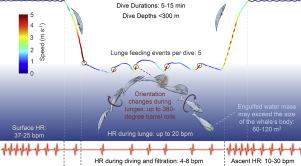Comparative Biochemistry and Physiology A: Molecular & Integrative Physiology ( IF 2.1 ) Pub Date : 2021-01-05 , DOI: 10.1016/j.cbpa.2020.110894 J A Goldbogen 1 , P T Madsen 2

|
The blue whale is the largest animal ever. This gigantism probably evolved to exploit seasonal krill blooms, where massive feasts allow for accumulation of large blubber reserves that can fuel their low mass specific metabolism during prolonged periods of fasting. Until recently, the physiology and biomechanics of blue whales could only be inferred from anatomical inspections, but the recent development of biologging tags now provide unique insights into how these ocean giants function and interact with their environment. Their mandibles, the largest bones ever to evolve, along with a highly expandable buccal cavity, enable an extreme and dynamic bulk feeding behavior. During a lunge feeding event, blue whales accelerate up to 5 m/s to engulf a volume prey laden water that is commensurate with the whale's gigantic body size. Perhaps due to the costs of such extreme foraging, their dive times of 10-15 min are much shorter than scaling would predict for their size. Like other diving animals, blue whales display a dive response with heart rates down to 4 BPM to prolong dive times and perhaps mitigate decompression sickness. Blue whales make the lowest and most energetic calls of any mammal with ocean traversing potential under natural ambient noise conditions. However, communication space may be severely reduced due to pervasive shipping noise. We hope that an increasing ability to study the physiology and behavior of blue whales and other marine megafauna will enable informed decisions and ensure our permanent co-existence in the face of increasing human encroachment into marine habitats.
中文翻译:

最大的八月克罗动物:重新审视蓝鲸的生理学和生物力学
蓝鲸是有史以来最大的动物。这种巨大的现象可能进化为利用季节性磷虾繁殖,在那里大规模的盛宴可以积累大量的鲸脂储备,从而在长时间禁食期间为它们的低质量特定代谢提供动力。直到最近,蓝鲸的生理学和生物力学只能从解剖学检查中推断出来,但最近生物记录标签的发展现在为了解这些海洋巨人如何运作和与环境相互作用提供了独特的见解。他们的下颌骨是有史以来最大的骨骼,加上高度可扩张的口腔,可以实现极端和动态的大量进食行为。在弓步进食事件中,蓝鲸以高达 5 m/s 的速度加速吞食与鲸鱼巨大的体型相当的充满猎物的水。也许由于这种极端觅食的成本,它们 10-15 分钟的潜水时间比缩放预测它们的大小要短得多。与其他潜水动物一样,蓝鲸会在心率低至 4 BPM 时表现出潜水反应,以延长潜水时间并可能减轻减压病。在自然环境噪声条件下,蓝鲸发出的叫声是任何具有穿越海洋潜力的哺乳动物中最低和最有活力的。然而,由于普遍的航运噪音,通信空间可能会严重减少。我们希望,越来越多的研究蓝鲸和其他海洋巨型动物的生理和行为的能力将能够做出明智的决定,并确保我们在人类对海洋栖息地的侵占日益增加的情况下永久共存。它们 10-15 分钟的潜水时间比缩放预测的它们的大小要短得多。与其他潜水动物一样,蓝鲸会在心率低至 4 BPM 时表现出潜水反应,以延长潜水时间并可能减轻减压病。在自然环境噪声条件下,蓝鲸发出的叫声是任何具有穿越海洋潜力的哺乳动物中最低和最有活力的。然而,由于普遍的航运噪音,通信空间可能会严重减少。我们希望,越来越多的研究蓝鲸和其他海洋巨型动物的生理和行为的能力将能够做出明智的决定,并确保我们在人类对海洋栖息地越来越多的侵占的情况下永久共存。他们 10 到 15 分钟的潜水时间比缩放对它们大小的预测要短得多。与其他潜水动物一样,蓝鲸会在心率低至 4 BPM 时表现出潜水反应,以延长潜水时间并可能减轻减压病。在自然环境噪声条件下,蓝鲸发出的叫声是任何具有穿越海洋潜力的哺乳动物中最低和最有活力的。然而,由于普遍的航运噪音,通信空间可能会严重减少。我们希望,越来越多的研究蓝鲸和其他海洋巨型动物的生理和行为的能力将能够做出明智的决定,并确保我们在人类对海洋栖息地越来越多的侵占的情况下永久共存。蓝鲸会在心率低至 4 BPM 时表现出潜水反应,以延长潜水时间并可能减轻减压病。在自然环境噪声条件下,蓝鲸发出的叫声是任何具有穿越海洋潜力的哺乳动物中最低和最有活力的。然而,由于普遍的航运噪音,通信空间可能会严重减少。我们希望,越来越多的研究蓝鲸和其他海洋巨型动物的生理和行为的能力将能够做出明智的决定,并确保我们在人类对海洋栖息地的侵占日益增加的情况下永久共存。蓝鲸会在心率低至 4 BPM 时表现出潜水反应,以延长潜水时间并可能减轻减压病。在自然环境噪声条件下,蓝鲸发出的叫声是任何具有穿越海洋潜力的哺乳动物中最低和最有活力的。然而,由于普遍的航运噪音,通信空间可能会严重减少。我们希望,越来越多的研究蓝鲸和其他海洋巨型动物的生理和行为的能力将能够做出明智的决定,并确保我们在人类对海洋栖息地的侵占日益增加的情况下永久共存。由于普遍的航运噪音,通信空间可能会严重减少。我们希望,越来越多的研究蓝鲸和其他海洋巨型动物的生理和行为的能力将能够做出明智的决定,并确保我们在人类对海洋栖息地的侵占日益增加的情况下永久共存。由于普遍的航运噪音,通信空间可能会严重减少。我们希望,越来越多的研究蓝鲸和其他海洋巨型动物的生理和行为的能力将能够做出明智的决定,并确保我们在人类对海洋栖息地的侵占日益增加的情况下永久共存。











































 京公网安备 11010802027423号
京公网安备 11010802027423号